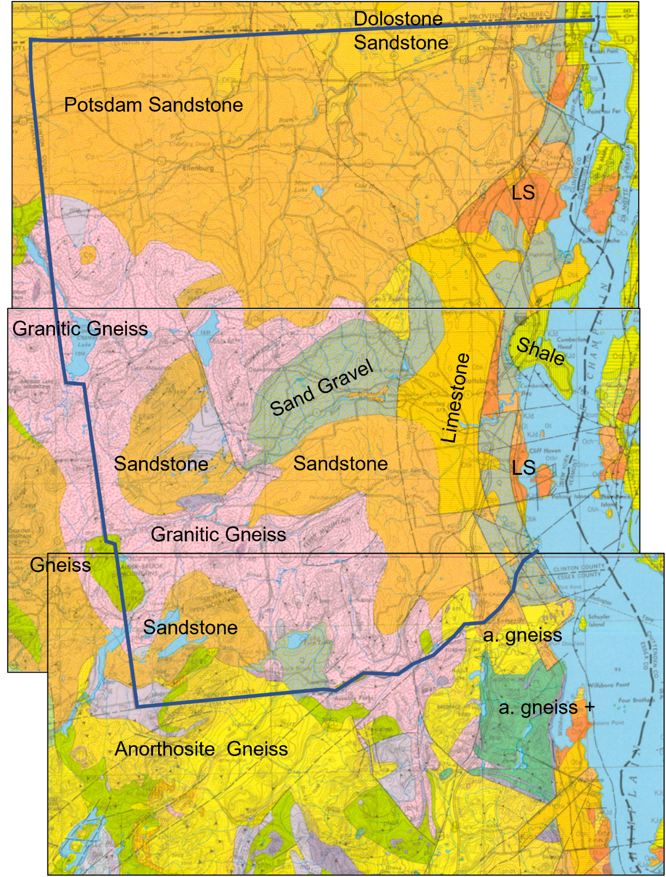Historically, the geology of Clinton County has impacted us in simple and complex ways, but we see its presence every day. There are five major geologic rock types in our County, each mined for its beauty and strength and seen in the buildings around us.

Adirondack Anorthosite of Clinton County is about 1 billion years old and found in much of the Adirondacks. A fresh rock surface of anorthosite has a light green tinge and can have large dark crystals. Many buildings and bridges use the rock for its aesthetic and structural characteristics. You can find it today on the AuSable Chasm Bridge where the greenish stone caps the stone railings and outlines the Potsdam Sandstone that forms the core of the bridge. The Church of the Holy Name in AuSable Forks, the St. John the Baptist Church in Keeseville and the steps of the old school in Clintonville, are all constructed of Adirondack Anorthosite.
Go swimming at AuSable Point and bring a magnet. Much of the sand at the beach is black and magnetic. The sand that coats your magnet washed down the AuSable River during the past 2 million years and came from eroded Adirondack Granitic Gneiss that outcrops in the southwestern part of the County. Most gneiss has very limited amount of iron rich minerals in it and that gneiss is used for construction because of its beauty and durability.
The gneiss with large amounts of iron in the minerals is an iron ore. Scores of mines near Palmer Hill and Lyon Mountain were worked to extract the iron rich Granitic Gneiss. Iron from these mines was used to make wire rope for the Brooklyn Bridge and rails for early American Railroads.
.png)
The Granitic Gneiss quarried for construction includes the St. James Episcopal Church, AuSable Forks; Champlain History Center, Champlain ; and cap of the Bridge Street bridge, Plattsburgh. Other historical and present uses of the Granitic Gneiss are less obvious or ornate. The roadside spring along Route 3 west of Dannemora lets citizens bring home water that is fresh tasting because it passes through the Granitic Gneiss. Chateauguay Lake and Chazy Lake are cradled in the Granitic Gneiss thus the lake water is crystal clear.
Tourists travel from all over North America to see sandstone formations of AuSable Chasm. Fewer tourists travel to Chateauguay Chasm to view a similarly deep but smaller chasm. Many old mills and hydroelectric plants in Clinton County capitalized on water falls and rapids that flow over Potsdam Sandstone.
About 500 million years ago, sand was deposited on the shoreline of primal North America. The primal continent had virtually no vegetation and the surrounding seas were almost barren of life. As a result, the sand has few fossils. Because the sand was deposited in shallow water, it has many fossilized ripple marks and iron in the sand combined with oxygen in the atmosphere creating rust which gives the sand its light red color.
Churches, factories, and homes in AuSable Forks, Churubusco, Keeseville, Peru, Redford and elsewhere, are constructed of Potsdam sandstone. The stone readily broke into blocks which made building construction easy. Redford glass was made by melting the quartz rich sand grains of the Potsdam sandstone.
.png)
Champlain Valley Limestone underlies much of eastern Clinton County, is fossil rich, and is used in many historical buildings of Plattsburgh and Chazy. Examples of buildings and structures made from Champlain Valley Limestone are: the Alice T. Miner Museum; the entrance gate and stone wall to Clinton County Community College; Our Lady of Victory, St. Peter’s, and St. Patrick’s Churches; the Bluff Point Lighthouse; and the Dannemora Prison Walls.
Clay, sand, gravel, cobbles, and boulders were picked up by the ten ice ages that moved glaciers across Clinton County during the past 2 million years. Nearly all glacial deposits in the Champlain Valley today are attributed to the most recent glacial episode. Cobbles and boulders are used to build walls, chimneys, houses, wells, and shrines. Glacial Sand is used to raise local roadways above wetlands like parts of the Adirondack Northway, and Delaware & Hudson Railroad. Glacial Sand areas are commonly used for landfills, graveyards, and swimming beaches at Plattsburg, AuSable Point, and Macomb Park.
Sand and clay deposits were quarried in unison to make bricks. Most historical brick buildings in Clinton County were likely built of local brick.
Enjoy the beauty and history of County rocks.